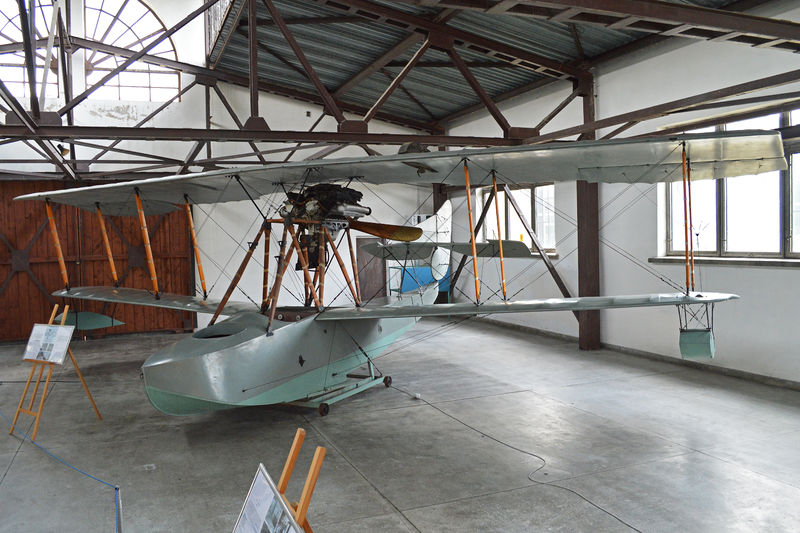Soubor:Grigorovich M-15 (262) (14213900909).jpg
Z Multimediaexpo.cz

Velikost tohoto náhledu je: 800 × 533 pixelů
Obrázek ve vyšším rozlišení (rozměr: 5 674 × 3 783 pixelů, velikost souboru: 17,25 MB, MIME typ: image/jpeg)
GIGANTICKÁ Fotografie + Description: In my opinion, early flying boats are a thing of beauty and this Russian built Grigorovich M-15 is no exception. It is the only surviving example of the 80 built and is c/n R.11C.262 It is on display in the 'WW1' hangar at the Muzeum Lotnictwa Polskiego. Krakow, Poland. 23-8-2013.
It's history is given in the following info taken from the museum website:-
"Since 1911, the Russian Imperial Navy employed French-built seaplanes (i.e. Farman, Borel and Léveque). The maintenance of the aircraft was performed at the S. S. Shchetinin & M. A. Shcherbakov Works in St. Petersburg. Since 1913 the works had been led by Dmitry Pavlovich Grigorovich. In the same year he designed, based on French originals, a successful M.1 aircraft with a boat-like fuselage. This was the beginning of a family of light flying boats, which served with distinction during the First World War.
In Autumn 1915 the Imperial Russian Navy issued an order for a heavier flying boat intended for long-range reconnaissance. In December 1915 Grigorovich built the M-9 type, which first flew on 9th January 1916. Notably, on 17th September 1916 the M-9 became the first flying boat to perform a loop, piloted by test pilot Jan Nagórski. A serious weakness of the design, however, was the licence-built Salmson-Unne radial engine. Therefore, in 1916 an improved variant designated the M-15 was built, powered by the excellent Hispano-Suiza V8 engine. Only 80 M-15 machines were built.
The Grigorovich M-15 was a long range flying boat biplane with the wing canopy placed over the fuselage, a pusher propeller and the empennage placed on a pylon, in the propeller's air stream, which increased the steering efficiency. The semi-monocoque wooden construction was covered with stressed plywood skin attached to open work formers. The wings and empennage were made of wood covered with fabric. Two stabilising floats were fitted at the ends of the lower wing.
The Grigorovich M-15 number R II C 262, built in 1917, was assigned to the fortress flight in Arensburg on the Osilia (Saaremaa) island in the fortified Moonsund archipelago, which guarded the entrance into Riga bay. These islands were captured by the Germans during land and naval campaign codenamed Operation Albion from the 10th to the 24th October 1917. The result was 20,130 POWs, 141 cannons and 10 aircraft captured among them, the R II C 262 flying boat. Tested in the Seaplanes Test Flight in Warnemünde, it eventually reached the German Aeronautical Collection in Berlin. Abandoned along with other wrecked remains of the collection in occupied Poland, found in 1945, in 1964 was moved over to the newly created Krakow's Museum as the only one, more or less complete, albeit damaged, First World War aeroplane. The restoration was undertaken by the end of the 1970s and was continued in the years 1991–1993. The aircraft is the only surviving M-15 example in the world."
- Date: 23 August 2013, 13:20
- Source: Flickr.com
- Author: Alan Wilson
+ pochází z Wikimedia Commons / Flickr.com , kde má status – Creative Commons Attribution-Share Alike 2.0 Generic license.
FLICKR --- https://www.flickr.com/photos/ajw1970/14213900909/
Historie souboru
Kliknutím na datum a čas se zobrazí tehdejší verze souboru.
| Datum a čas | Náhled | Rozměry | Uživatel | Komentář | |
|---|---|---|---|---|---|
| současná | 22. 8. 2015, 13:22 |  | 5 674×3 783 (17,25 MB) | Sysop (diskuse | příspěvky) | (GIGANTICKÁ Fotografie + Description: In my opinion, early flying boats are a thing of beauty and this Russian built Grigorovich M-15 is no exception. It is the only surviving example of the 80 built and is c/n R.11C.262 It is on display in the 'WW1' hang) |
- Editovat tento soubor v externím programu (Více informací najdete v nápovědě pro nastavení.)
Odkazy na soubor
Na soubor odkazuje tato stránka:
